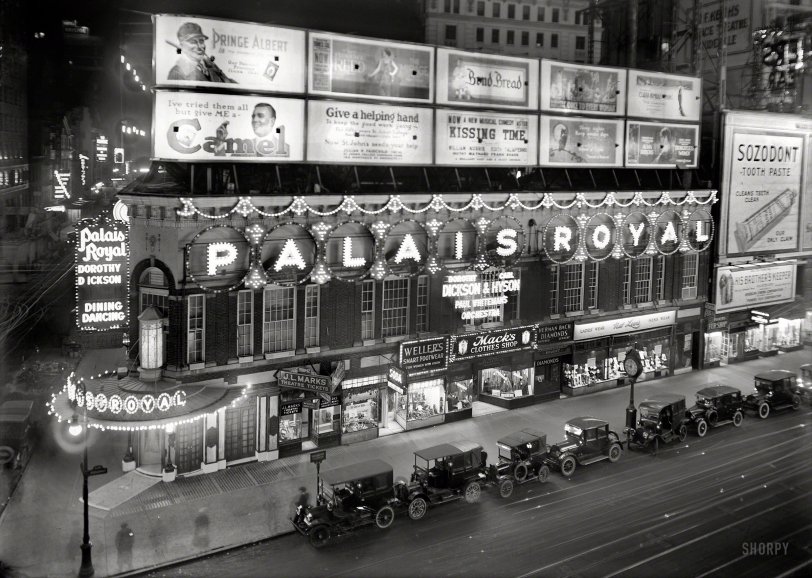


Framed or unframed, desk size to sofa size, printed by us in Arizona and Alabama since 2007. Explore now.
Shorpy is funded by you. Patreon contributors get an ad-free experience.
Learn more.

- Tough Guys
- Lost in Toyland
- And without gloves
- If I were a blindfolded time traveler
- Smoke Consumer Also Cooks
- Oh that stove!
- Possibly still there?
- What?!?
- $100 Reward
- Freeze Frame
- Texas Flyer wanted
- Just a Year Too Soon
- WWII -- Replacing men with women at the railroad crossing.
- Yes, Icing
- You kids drive me nuts!
- NOT An Easy Job
- I wonder
- Just add window boxes
- Icing Platform?
- Indiana Harbor Belt abides
- Freezing haze
- Corrections (for those who care)
- C&NW at Nelson
- Fallen Flags
- A dangerous job made worse
- Water Stop
- Passenger trains have right of way over freights?
- Coal
- Never ceases to amaze me.
- Still chuggin' (in model form)
Print Emporium
Palais Royal: 1920

New York circa 1920. "Palais Royal, Broadway." Where, whether you're Prince Albert, Dorothy Dickson or a tube of Sozodont, you can see your name in lights. 5x7 glass negative, George Grantham Bain Collection. View full size.
Palais d'Or
... was the establishment that succeeded the Palais Royal about 1928. Cuisine transitioned from French to "Chinese-American," and B.A. Rolfe's orchestra was the big attraction. He made Edison records, and later conducted on the Lucky Strike Hour.
By 1932 Graham Prince's band was resident at the Palais. RCA brought them in for "cheap records" (the official term -- no one called them "budget line"), which are very rare because no one wanted recorded music any longer, even at 20 cents a throw.
No booze!
A nightclub at Times Square and no liquor! I'll bet a LOT of people brought flasks tucked away here and there. They certainly couldn't have operated as a speakeasy with such a high profile. I wonder what they served.
What's Going on Shorpy People?
The first comment that I expected to read would be about "Prince Albert in a can" and letting him out. What's going on with you Shorpy people?
The King of Jazz
Paul Whiteman, "The King of Jazz," led one of the country's most popular dance bands in the 1920s. He commissioned George Gershwin's "Rhapsody in Blue" and conducted its premier with Gershwin playing the piano. He also commissioned several works from Ferde Grofe', notably "Grand Canyon Suite". Bix Beiderbecke played in his orchestra. Bing Crosby was hired by Whiteman in 1926. He hired several African-American musicians.
As a sign of his fame, his rotund physique and pencil-thin moustache were parodied in Looney Tunes cartoons.
The Palais Royale was the place for Whiteman and his orchestra.
1920
Kissing Time at the Astor closed on December 4, 1920 (opened on November 8). The billboard for His Brother’s Keeper (opening February 14, 1921) must have been a “Coming Soon.”
Paul Whiteman's Orchestra was first class
It premiered George Gershwin's "Rhapsody in Blue" just 4 years later at Aeolian Hall with Gershwin himself at the piano. Whiteman said later he was surprised to realize at some point during the main theme that tears were running down his cheeks.
Even in sophisticated Manhattan
Bond bread, the foundation of many a Midwestern mom's tasteless bologna sandwiches.
Sozodont
Interesting that by 1920 the Sozodont slogan is that it will "clean teeth" and that is "Our Only Claim".
Perhaps this is because they had been making extravagant claims since the 1880's and even claimed that X-rays showed the difference between teeth with Sozodont and those without. According to Wikipedia, it was determined that the product actually destroyed the enamel on your teeth, leading to a golden-yellow smile.
Carriage call
Mounted at the bottom of the corner sign, under "Dining Dancing," a minor Shorpy favorite, an electric carriage call. Other examples noted in this comment.
Progeny
The Latin Quarter Nightclub was owned by Lou Walters, the father of Barbara Walters.
A Thousand Points of Lighting
The grids on the sidewalk are glass blocks to allow light into the basements. Very few of these remain in New York City to this day.
Nightclub hotspot
Located on the short block of West 48th Street between Broadway and Seventh Avenue, the Palais Royal was the city's first true nightclub. It was known for its exclusivity and very high prices, the spiritual predecessor of the modern clubs with their VIP rooms and $400 bottles of Grey Goose. All patrons were required to wear evening clothes.
The Palais Royal closed sometime in the late 1920's/early 1930's. After going through some ownership changes, in 1942 the building became the site of what may have been New York's most famous nightclub, the Latin Quarter. It featured A-list entertainment and a chorus line and attracted tens of thousands of customers each year. Beset by labor troubles and changing customer preferences, the Latin Quarter closed in the late 1960's and the building remained vacant for years, though the owners made money from the many huge advertising signs adorning the exterior. It finally came down in the 1980's and the Renaissance Hotel now occupies the site.
The sidewalk glass blocks noted in another comment were used to provide lighting not for basements per se, but for unfinished hollow spaces known as sidewalk vaults that extended under the sidewalks from basements. Contractors routinely built them when constructing commercial buildings and many building owners used the vaults as extra storage.
Some time ago, I believe in the 1950's though I'm not certain, the city began charging building owners rent for use of the vaults, which technically were city property. In response most owners walled off the vaults from their basements and naturally enough lost any interest in maintaining the glass blocks.
























On Shorpy:
Today’s Top 5